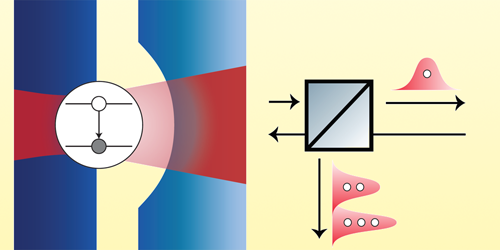Photon “Sifter” Separates Single Photons from Multiphoton States
Controlling interactions between photons could lead to new technologies including all-optical quantum computers. Taking a step toward this goal, Richard Warburton of the University of Basel, Switzerland, and his colleagues have demonstrated a device whose input is a weak laser and whose output is a stream of single photons from one port and groups of multiple photons from another port [1]. The ability to separate single-photon states from multiphoton states could lead to a photonic logic gate in a quantum computer. For example, the states of two independent photons entering such a gate could determine whether they depart independently or as a two-photon unit.
The device contains a 20-nm-wide island of semiconductor (a quantum dot) embedded within one of the two reflective walls of an optical cavity. Light enters and exits the cavity through the opposite wall, which is partially transparent. The incoming weak laser light can be thought of as a combination of single photons, photon pairs, photon triplets, and so on. Like an atom, the quantum dot absorbs a single photon whose energy matches the separation of two of its energy levels and then emits a photon with the same energy. But if two or more photons are present, the interaction changes, which, in this setup, changes the polarization of the output state. By directing this output through a polarization-sensitive beam splitter, the device selects the port through which the output light is emitted based on the number of photons that interact with the quantum dot.
Analyzing the multiphoton output, the team determined the so-called second-order correlation function, a measure of the “bunching” of photons—essentially, the absence of single-photon states. They found a value of 587, whereas the highest value from previous experiments was about 20.
–David Ehrenstein
David Ehrenstein is a Senior Editor for Physics Magazine.
References
- N. Tomm et al., “Realization of a coherent and efficient one-dimensional atom,” Phys. Rev. Lett. 133, 083602 (2024).




